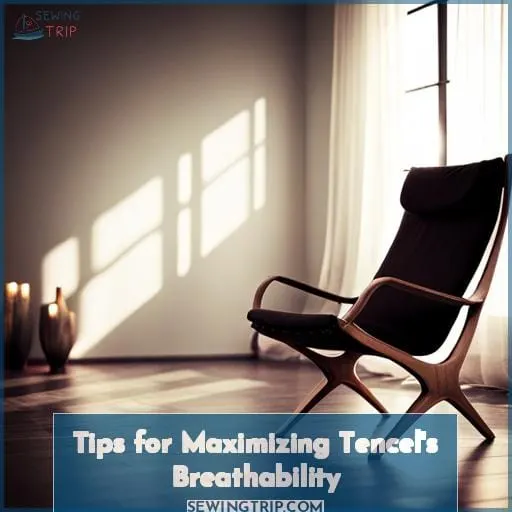This site is supported by our readers. We may earn a commission, at no cost to you, if you purchase through links.

In this article, we explore the breathability of Tencel fabric compared to other fabrics on the market, as well as factors affecting its air permeability. We also provide tips on how to maximize tencel’s breathability for maximum comfort throughout any season.
Table Of Contents
Key Takeaways
- Tencel is a sustainable fabric made from wood pulp, with a closed-loop manufacturing process.
- Tencel has moisture-wicking properties that pull sweat away 50% faster than cotton, making it ideal for hot sleepers who want breathable sheets.
- The breathable nature of Tencel helps regulate body temperature by adapting to various conditions and ambient temperatures.
- Tencel sheets outperform synthetic fabrics like polyester when it comes to breathability and are a superior choice for well-ventilated bedding.
What is Tencel Fabric?
You’ll love how a set of Tencel sheets lets airflow circulate around your body as you sleep, keeping you cool and comfy all night long. Tencel, known also as lyocell, is a sustainable fabric made from wood pulp. Its breathability comes from moisture-wicking properties that pull sweat away from your skin.
The fabric’s moisture absorption happens very quickly, up to 50% faster than cotton. This quality makes Tencel sheets ideal for hot sleepers who want airflow and temperature regulation.
Tencel’s closed-loop manufacturing process makes it an eco-friendly choice. Easy care through machine washing preserves the silkiness that maintains even after repeated launderings.
Choosing Tencel sheets means selecting an environmentally responsible option that feels lush against your skin.
The Breathability of Tencel
Let’s talk about Tencel’s breathability. Tencel fabric absorbs moisture 50% faster than cotton to wick perspiration away from your skin. Its breathable, airy weave allows airflow to help regulate your body temperature and keep you cool.
The lightweight, porous nature of Tencel promotes ventilation against the skin. With an advanced fiber structure, Tencel rapidly moves moisture away from the body and dries quickly, supporting your body’s natural thermal regulation.
The bio-based fabric also resists odor thanks to its moisture-management properties. Offering next-to-skin softness, Tencel keeps you comfortably dry during any activity.
Moisture-Wicking Properties
When it comes to the perspiration-soaked linens clinging to your body on a scorching summer night, moisture-wicking Tencel fabric whisks sweat away quicker than a parched camel at an oasis. The cooling effect of Tencel’s unmatched moisture absorption liberates you from the damp confinement of cotton, enabling breezy slumber and adept humidity regulation through its unrivaled moisture-wicking properties.
Tencel’s peerless perspiration dissipation frees you to sleep soundly on muggy nights.
Regulation of Body Temperature
Tencel sheets help regulate your body temperature.
- They wick away moisture for dry, comfortable sleep.
- They allow air circulation to help disperse body heat.
- They adapt to both warm and cool conditions.
- They resist overheating even in hot, humid weather.
The breathable structure of Tencel regulates your body temperature all night for quality, uninterrupted sleep.
Airflow and Ventilation
Tencel’s breathability comes from the airflow through its fibers. The fabric’s structure allows ample ventilation to flow between the fibers. This airflow pulls heat and moisture away from your skin. As you move in bed, air circulates through the fabric.
Tencel’s breathable nature helps regulate your temperature for sleeping comfort.
How Does Tencel Compare to Other Fabrics in Terms of Breathability?
When choosing bedding, breathability should be a top priority for temperature regulation and moisture wicking. Compared to cotton’s average breathability, Tencel absorbs moisture at a quicker rate while linen offers the most airflow.
However, Tencel’s breathability surpasses synthetics, which retain heat. Rather than relying on weave or fiber like more natural fabrics, these smooth-surfaced textiles have less capacity for ventilation regardless of their composition.
Tencel Vs. Cotton
Tencel vs. Cotton
You’re craving those silky-soft sheets, but should you go for the breathable Tencel or the tried-and-true cotton? The moisture-wicking and quick-drying properties of Tencel offer a silky smooth feel perfect for hot sleepers.
Yet, cotton’s softness and durability make it a classic bedding choice. As a sustainably-sourced, ultra-soft alternative to cotton, Tencel’s breathability and luxurious hand may win you over. However, cotton’s longevity and affordable options keep it a popular fabric choice.
Tencel Vs. Synthetic Fabrics
You’ll find that Tencel sheets breathe better than polyester due to their natural fiber construction. For instance, my sister swapped her synthetic sheets for Tencel and noticed a huge difference in temperature regulation.
The breathable Tencel fabric, made from eucalyptus, wicks moisture and regulates temperature far better than non-breathable synthetics like polyester, nylon, acrylic, and spandex. Tencel’s superior breathability comes from its eco-friendly, closed-loop production process that yields an exceptionally soft, moisture-wicking fabric.
Tencel Vs. Linen
Linen is praised for its breathability, but you would find Tencel is just as cooling and airy. Tencel’s advanced fiber technology creates a highly breathable, moisture-wicking fabric. Its cross-section improves airflow, preventing heat buildup. Though linen’s natural fibers allow airflow, Tencel’s smooth, sleek fibers optimize breathability.
For sheets and summer outfits, Tencel’s cool-to-the-touch feel surpasses linen. Tencel’s breathable qualities make it ideal for temperature regulation and hot sleepers.
Factors Affecting Tencel’s Breathability
The open weave, high thread count, and thin profile of Tencel make it one of the most breathable fabrics. While these factors maximize its breathability and cooling comfort, certain design choices can restrict airflow and negate some of Tencel’s innate advantages.
The lightweight nature of the fabric allows air to easily pass through, rapidly wicking moisture away from the body. However, aspects like tight garment construction and dense stitching patterns can inhibit breathability.
Additionally, the finishes and treatments applied to Tencel after production, such as water repellents, may affect the textile’s porous structure. Although Tencel is intrinsically breathable, fashion designers must carefully consider how their construction methods and embellishments either capitalize on or counteract the exceptional ventilation of the fabric.
With mindful design choices, brands can fully harness the remarkable breathable properties of Tencel.
Weave and Texture
You’d know the weave and texture really matter for how breathable any fabric turns out. The tight, flat texture of percale weave provides more airflow than the softer, looser sateen weave. Tencel’s smooth and consistent texture allows excellent airflow for its cooling properties.
With tencel sheets, the weave selection controls airflow; percale promotes maximum breathability while sateen limits it. For the best cooling properties, choose a percale tencel with a tight, crisp texture.
Thread Count
Breathe easy knowing even high thread counts can’t smother Tencel’s natural breathability. 1) Tencel’s moisture-wicking structure. 2) Its thermal regulating properties. 3) The fiber spacing for airflow.
4) The breathable eucalyptus origins. All this ensures comfort regardless of thread count, as Tencel’s inherent breathability overpowers dense weaves.
- Tencel’s moisture-wicking structure keeps you cool and dry.
- Its thermal regulating properties maintain a comfortable body temperature.
- The fiber spacing allows for effective airflow.
- The breathable eucalyptus material origins maximize breathability.
Tencel offers tailored breathability from its sustainably sourced eucalyptus fibers. Unlike cotton, Tencel maintains its breathable and moisture-wicking properties even at higher thread counts. While high thread count cotton can feel oppressively warm, Tencel’s breathability comes from inherent fiber spacing and thermal regulating abilities.
This makes Tencel sheets ideal for hot sleepers or climates. For naturally cool and breathable bedding, choose eucalyptus-based Tencel over cotton.
Fabric Thickness
The ethereal fabrics like Tencel allow your skin to feel the breeze, as a wispy veil reveals beauty while barely there at all.
| Fabric Thickness | Advantages | Disadvantages |
|---|---|---|
| Thin | Thermal regulation, moisture absorption, airflow dynamics, heat dissipation | Less durable |
| Medium | Balanced breathability and durability | |
| Thick | Durability | Reduced breathability, thermal regulation |
Tencel’s breathable qualities depend partly on the fabric’s thickness. More sheer fabrics maximize airflow and cooling. Thicker fabrics prioritize durability while decreasing breathability. Medium density strikes a balance between the two.
Tips for Maximizing Tencel’s Breathability
You’ve made an excellent choice selecting Tencel for its renowned breathability and moisture control. To maximize Tencel’s cooling properties, focus on proper care and maintenance, try layering and blending fabrics, and choose the right Tencel products designed for breathability.
Proper Care and Maintenance
- Wash in cool or cold water. Hot water can damage fibers.
- Use a gentle, eco-friendly detergent. Harsh chemicals can strip Tencel’s natural softness.
- Never use bleach. It weakens fibers over time.
- Line or flat dry. Heat from dryers degrades fabric.
- Iron on low when needed. High heat causes damage.
Handle your breathable Tencel bedding with care and it will sing with joy night after night.
Layering and Mixing Fabrics
You’ll enhance this fabric’s airflow when layering it under cotton, as studies show tencel whisks moisture away 50% faster. Mix tencel with breathable cottons and linens when designing outfits needing excellent ventilation.
Layering allows fabrics to maximize their strengths; the tencel wicks perspiration while the cotton absorbs it. For warm seasons, pair tencel with lightweight, airy fabrics on top. Combining moisture-wicking and quick-drying fabrics boosts cooling properties and airflow for greater comfort.
Choosing the Right Tencel Products
A lightweight tencel shirt will let your skin breathe on hot summer days.
- Look for 100% Tencel lyocell or modal fabrics.
- Choose lightweight, gauzy weaves.
- Seek out moisture-wicking properties.
- Select ultra-soft and smooth fabrics against skin.
- Favor pieces with ventilation and airflow.
When selecting Tencel products, focus on pure fabrics in breezy weaves that keep you cool and dry. Seek out soft, smooth handfeels and anti-bacterial properties ideal for sensitive skin. Prioritize breathable bedding, apparel, and activewear perfect for sweaty weather.
Conclusion
Do you want to stay comfortable and relaxed while you rest? Tencel fabric is an excellent choice for those seeking breathable bedding. Its moisture-wicking properties, temperature regulation, and air circulation make it ideal for hot sleepers.
While it is more expensive than some cotton options, it is a great investment for the long term. Additionally, it is eco-friendly and biodegradable. To maximize breathability, make sure to select the right products and practice proper care.
Tencel is an excellent breathable fabric with superior properties compared to other materials, making it a great choice for bedding.











